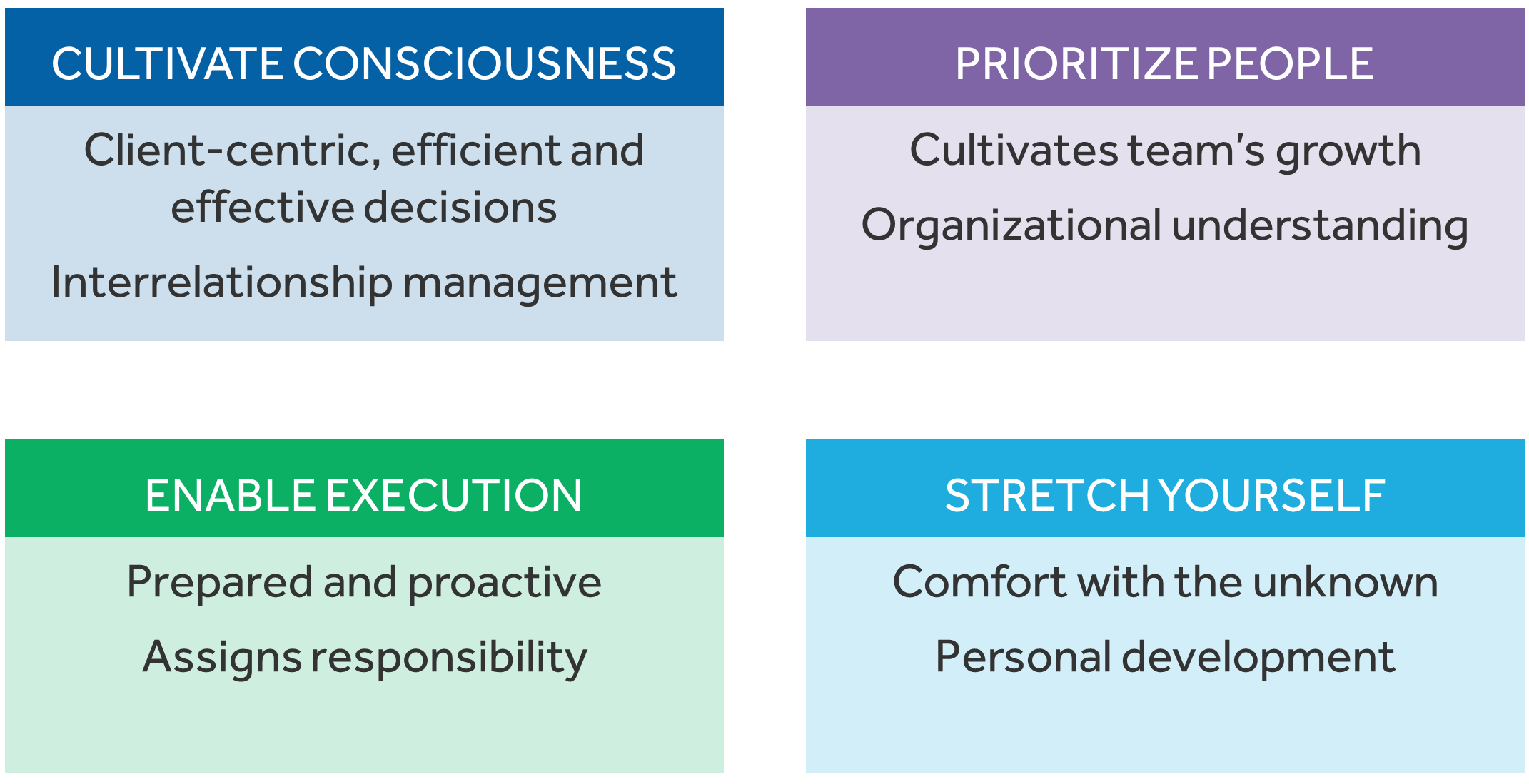Leading Self and Teams Through Complexity:
An Intensive Accelerator Program for Emerging Retail Leaders
Abstract
District Leaders at a leading beauty retailer need to advance from managing a single store to managing other leaders. They must first gain insight into their own leadership style and capabilities and then expand their skills to tackle the complexities of a multifunctional role. This program spans two and a half days and includes facilitator-led discussions and simulation-based decision-making. It has touched more than 50 leaders in two years, providing them with actionable models and tools to use back on the job.

Challenge
District Leaders manage a set of retail stores within a region and are expected to be fully conversant on the P&L of each store as well as the staffing and people challenges. They must also develop their people management skills, think strategically about their district challenges, and adapt to a changing industry. Those most effective in this role learn how to scale themselves; that is, they develop their store managers to act as the District Leader would, even when they are not there themselves.
Solution
The Leading Self and Teams Through Complexity program is designed to address the challenges District Leaders face, which include managing stated priorities and KPIs and growing themselves and their management staff. The program places these leaders in familiar territory: The business simulation presents them with a retail store district with people and business challenges that mirror their work back on the job. As they prepare for each round of the simulation, they learn skills and perspectives that will help them consider the scenarios presented to them. They draw on their own experience and the learning from the classroom, working in small teams to grow their fictional business. As they finish each simulation round, participants engage in exercises to relate this experience to their real-life roles. In this iterative way, essential leadership tools and skills practice are woven throughout the program so that participants leave with practical methods for the continuing development of their leadership capability.
Learning Objectives
Participants develop and improve skills to:
- Think strategically in order to prioritize their actions and set clear direction.
- Deliver results by leading and managing through change in the organization and the market.
- Coach and develop people to improve motivation and performance.
- Communicate effectively (up, down, and across) in an organization.
Design Highlights
The program’s design builds on itself, teaching concepts in multiple ways and in a consistently interactive manner. A combination of small team and group exercises complements the challenges posed in the simulated business environment. In every module, participants apply the learning to both the task at hand and to their real-life roles.
Program Agenda:
| Day One |
|
| Day Two |
|
| Day Three |
|
The Leading Self and Teams Through Complexity program features content on:
- Strategic time management.
- The setting of direction and key strategic priorities.
- The measurement of a team's performance via business skills, people skills, and motivation.
- Effective strategic communication across the organization and its impact on leadership.
The program also includes content from a partner company and incorporates segments on:
- Building effective teams.
- Self-awareness.
- Coaching (productive inquiry and advocacy).
- Change leadership and managing transitions.
- Strategic agility.
This is an excellent complement to the simulation's own content and makes for a well-rounded leadership program.
Challenge Application:
At the client's request, this simulation closely mirrors the work of participants back on the job, which means they are able to dive in with familiarity. At the same time, the district that participants face in the simulation has its own novel set of challenges and gives teams the opportunity to use it as a laboratory of sorts for experimenting with newly learned leadership skills.
Simulation Overview
| Helena is a Swedish cosmetic company founded in 1975 and is the daughter company of Hosk and Larsson, a luxury goods conglomerate headquartered in Stockholm: |
- Helena, which has the largest market in the United States, currently has 2,000 stores across the globe. Last year, the prestige beauty products market in the U.S. was $15.9 billion, with makeup sales contributing $7.3 billion.
- As one of the top beauty retailers in the region, Helena saw much of this growth. Still, changes to purchasing behaviors have resulted in a challenging year for brick-and-mortar stores.
- Helena has started putting a heavy emphasis on service to differentiate in-store from online purchasing experiences.
- Last year, the company reported $150 million in sales revenue. Their mission is “Beauty in All We Do.”
Helena’s leaders recently articulated the strategic priorities for the business:

The participant’s role is the newly promoted District Manager of the Newminster district of Helena. They were transferred to Newminster and do not have existing relationships with their store staff. They have 11 stores with $70 million in annual revenue. It is an average performing district.
The participant's leadership challenge, noting that Newminster is not a “turnaround” district, is to drive the results in their district by:
- Developing the people and business skills of their team.
- Increasing motivation across the district through their leadership decisions.
- Partnering with other corporate and district resources, where appropriate.
- Strategically managing their time in order to balance the short-term and long-term needs of a diverse portfolio of stores.
- Communicating effectively across the organization.
History and Results
The Leading Self and Teams Through Complexity program ran for two years at sessions to which the client's top District Leaders were invited. These employees were considered rising stars at the company. The client wanted a program that would give this group tools they could immediately use, as well as expanded perspectives on leadership. This program enabled their successful continuation on the promotion path.
Participants have reported that the simulation is a rewarding challenge. For this program's pilot, each round of decision-making generated robust conversations in the teams, and every participant was engaged throughout the sessions. A number of participants reported that they felt the simulation had accurately captured the real issues that they and their District Managers routinely face.










